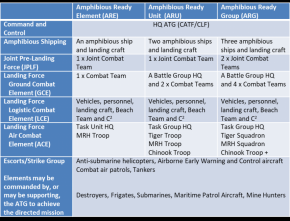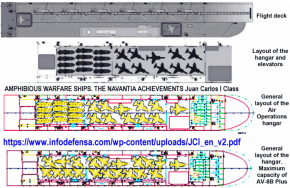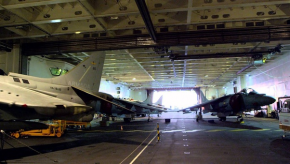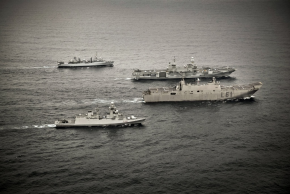View attachment 48192
Its 20 AV8 Harriers, in the hangar, and its ferry only. (
View topic - F-35Bs Establishing potential of Australian aircraft carrier - F-35 Variants and Missions). Based off the original image by Bazan what is now Navantia created long ago back when it was the BPE and before it was in the water, trying to push the project through. While the F-35B and the harrier are of similar size they aren't exactly the same. I doubt 20 harriers would ever even be ferried in a JC1 design, I would bet physically you wouldn't be able to, and when it comes to F-35's its going to be significantly less. Some people then claim 32 with another 12 on the deck, again, this is not a useable number, this is "in theory" napkin calculation, ferry, too many aircraft operations could not occur with this many aircraft.
Spain has not operated the JC1 with more than 11 Harriers AFAIK, and that would be in full carrier mode. That is a reasonable maximum, and throw in 3-4 helicopters. Think of Spains carrier history, the JC1 "replaced" the Principe de Asturias, a 15,000t "carrier", which was designed around 12 harriers at a light tempo. PdA replaced Dedalo a wwII USS Cabot, 11,000t, which operated with 8 harriers. All three are not optimal full time carriers, but more sea control/escort carriers. But a pocket carrier is all some countries need. Spain intended to operate either in range of airfields, or with other carriers.
View attachment 48193
Spanish actually using the LHD hangar with harriers in a far more logical arrangement
The LHD's aren't designed as a carrier to project power against a peer force either land or sea based. Spain never designed or built them for that purpose. Its for very mild at sea aviation capability, supported by nearby airfields, against an enemy with no/weak naval air capability in that area. They aren't 24/7/365 CAP assets. The deterrent is having aircraft on the deck, not flying regular patrols.
Australia could surge two LHD's, and get something approaching a dedicated carrier, able to support a squadron of aircraft (~12 per ship) at a reasonable tempo, with say 4-8 helicopters. But you have now tied up the entire RAN (surface force, amphibious force, fleet supply, submarines etc) to provide that force, for a short period. You have tied up/negated all the amphibious capability basically of the army too. And the RAAF would be significantly tied to this as well. You will need escorts as well. How much training will we get to practice and operate this kind of short term but intense capability?
I would add that neither the Italians nor the Japanese are intending their carriers to be extraordinary blue water assets. We are talking 12-16 aircraft. Operating with ground bases. Im not sure the investment in a Cavor type ship gets us where we would need to be in terms of carrier power. Cavor is made for the Mediterranean, not for long and open oceans like the Pacific or the Indian ocean.
View attachment 48194
Cavor and Juan Carlos operating together.
https://flic.kr/p/mDPZ7H
So are we looking at a 40,000-65,000t carrier? Korean CVX or QE class? 1.5-2.0 squadrons? How does such a program come about? Where does the crew come from? The pilots? Where does the budget come from? Which service is spear heading this? Where is the political support?
Or are we looking at something more like a 3rd LHD replacing choules, 0.5-1.0 Squadron F-35b's (replacing the Shornets) and embarking a small number ad hoc and still primary focusing on land based aircraft. Combined with an increase in our ASW capability with additional Romeos. Utilizing existing training, logistics, procurement etc. While at the same time further supporting our amphibious and HDAR/non war capability.





